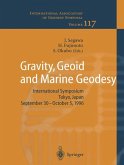This text on gravity methods in geophysics is intended for students and earth scientists of all kinds e.g., geophysicists, geologists, and geodesists. It is structured in 7 chapters covering the basic problems and tasks: data acquisition and analysis; qualitative and quantitative geological interpretation aspects involving the basic theory of gravitation and its potential; methods of integration to solve "forward problems", and the theory of Bayesian inversion with a priori information offering many means of evaluating the results. The ideas are illustrated and documented by many practical examples on scales, from the search of cavities to global geodynamics. Tasks or problems (with solutions) for students to solve are included, plus a guide to related texts and a subject index.
Gravity interpretation involves inversion of data into models, but it is more. Gravity interpretation is used in a "holistic" sense going beyond "inversion". Inversion is like optimization within certain a priori assumptions, i.e., all anticipated models lie in a limited domain of the a priori errors. No source should exist outside the anticipated model volume, but that is never literally true. Interpretation goes beyond by taking "outside" possibilities into account in the widest sense. Any neglected possibility carries the danger of seriously affecting the interpretation. Gravity interpretation pertains to wider questions such as the shape of the Earth, the nature of the continental and oceanic crust, isostasy, forces and stresses, geol- ical structure, nding useful resources, climate change, etc. Interpretation is often used synonymously with modelling and inversion of observations toward models. Interpretation places the inversion results into the wider geological or economiccontext and into the framework of science and humanity. Models play a central role in science. They are images of phenomena of the physical world, for example, scale images or metaphors, enabling the human mind to describe observations and re- tionships by abstract mathematical means. Models served orientation and survival in a complex, partly invisible physical and social environment.
Gravity interpretation involves inversion of data into models, but it is more. Gravity interpretation is used in a "holistic" sense going beyond "inversion". Inversion is like optimization within certain a priori assumptions, i.e., all anticipated models lie in a limited domain of the a priori errors. No source should exist outside the anticipated model volume, but that is never literally true. Interpretation goes beyond by taking "outside" possibilities into account in the widest sense. Any neglected possibility carries the danger of seriously affecting the interpretation. Gravity interpretation pertains to wider questions such as the shape of the Earth, the nature of the continental and oceanic crust, isostasy, forces and stresses, geol- ical structure, nding useful resources, climate change, etc. Interpretation is often used synonymously with modelling and inversion of observations toward models. Interpretation places the inversion results into the wider geological or economiccontext and into the framework of science and humanity. Models play a central role in science. They are images of phenomena of the physical world, for example, scale images or metaphors, enabling the human mind to describe observations and re- tionships by abstract mathematical means. Models served orientation and survival in a complex, partly invisible physical and social environment.








